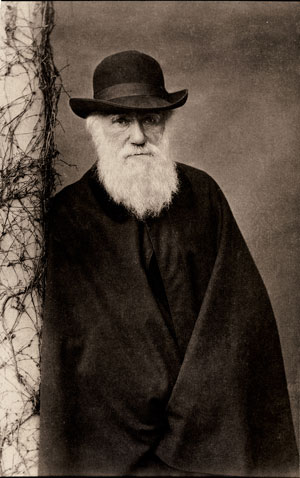
Charles Darwin's On the Origin of Species was published 150 years ago. It revolutionized biology, introducing the concept of evolution through natural selection. His ideas helped shape the foundations of evolutionary biology and continue to spark debate today. Delve into the books and media below to learn more about Darwin and evolution.
Sís, Peter. The Tree of Life. : A Book Depicting the Life of Charles Darwin, Naturalist, Geologist and Thinker New York: Frances Foster Books, 2003.Sís tells the story of Charles Darwin’s life – public, private and secret - through words and beautiful illustrations. The Tree of Life covers the main events in Darwin’s life, but it is much more than that. It explores the revolution that Darwin started with the publication of On the Origin of Species and chronicles the opposition it faced, as well as examining the doubts Darwin had about publishing this work. The book includes many extracts from Darwin’s diaries, as well as charts and maps from his explorations. |
 |
Evolution: Darwin’s Dangerous Idea [DVD]. Boston, MA: WGBH, 2001. (Disc 1 of 4).This 2-hour DVD intersperses a dramatization of Darwin’s life with more detailed explorations of different aspects of his theory of evolution. For example, after Darwin hypothesizes about natural selection leading to the evolution of species, there is a chapter on how HIV evolves to overcome different medications, and how doctors are using this knowledge to fight the disease. The dramatization chapters can also be viewed together for younger viewers, as they work as a stand-alone explanation. |
 |
Mindell, David P. The Evolving World: Evolution in Everyday Life. Cambridge, MA: Harvard University Press, 2006.With what would be Darwin’s 200th birthday this year, evolution seems to be popping up everywhere. For many, however, evolutionary biology remains a somewhat confusing science that might not seem relevant to their everyday lives, or it is simply the field that fuels the evolution versus intelligent design debate. Academy scientist Mindell provides alternative ways of looking at evolutionary biology, demonstrating how key concepts and processes from the field are in fact applied in a myriad of ways in our society, from the breeding of agricultural plants and animals to forensic science used in court cases and even the parallels between evolution and cultural and religious development. Written in an engaging and accessible manner Mindell clearly demonstrates that, “evolution is not just useful, it is indispensable.” |
 |
Read an engaging book or seen a fabulous movie about evolution? Share the title and why you liked it with us below in our comments section.
Featured Creatures

Photo: G. Sharlow.
Underwing Moth
The North American underwing moth (Catocala species) readily blends in among the bark it rests upon during the day. In the past, those individuals that didn’t hide themselves as well were plucked off by hungry birds, leaving behind the mottled brown moths that did a better job of going undetected. If camouflage wasn’t enough to fool curious predators, most underwing species have also developed colorful underwings to startle them. Exposing hidden orange, red, or white splashes of color either gives the moth a few spare seconds to flee or scares away the potential threat.

Photo: G. Sharlow.
Dead Leaf Butterfly
This Indo-Australian butterfly (Kallima inachus) has evolved a more impressive way to go incognito. Its dull brown wings are dead ringers for dead leaves, even down to some of the finest details. A false midrib extends right along the middle of the mimic’s wings, while the bottom tips resemble a leaf stem. The wings even have a few seemingly nibbled-upon holes, crunched edges, and small fungus-like dark patches. Like the underwing moth, the dead leaf butterfly also has a flashier side. Its undersides reveal bright yellowish orange with shimmering indigo.
Naturalist Alfred Russel Wallace was particularly amazed by the various dead leaf butterflies he found on his travels. They were “the most wonderful and undoubted case of protective resemblance in a butterfly” he had ever seen. Their mimicry is part of what helped shape his theory of natural selection, which he codiscovered with Charles Darwin.